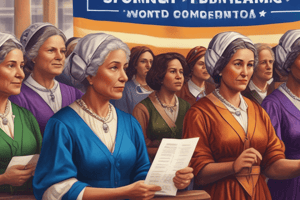Podcast
Questions and Answers
The National Women’s Rights Convention, which hosted over 1000 people from 11 states, was a significant step in solidifying the goals of the women’s ______ movement in the United States.
The National Women’s Rights Convention, which hosted over 1000 people from 11 states, was a significant step in solidifying the goals of the women’s ______ movement in the United States.
suffrage
The American Equal Rights Association (AERA), founded in 1866, aimed to secure suffrage for all U.S. citizens regardless of race, gender, or ______.
The American Equal Rights Association (AERA), founded in 1866, aimed to secure suffrage for all U.S. citizens regardless of race, gender, or ______.
color
In 1869, a major disagreement arose within the AERA concerning the 15th Amendment, specifically whether Black men should have the right to vote before ______.
In 1869, a major disagreement arose within the AERA concerning the 15th Amendment, specifically whether Black men should have the right to vote before ______.
women
Following disputes over the 15th Amendment, the women's suffrage movement split, leading to the formation of the NWSA and the AWSA; the NWSA, led by Stanton and Anthony, did not support the 15th ______.
Following disputes over the 15th Amendment, the women's suffrage movement split, leading to the formation of the NWSA and the AWSA; the NWSA, led by Stanton and Anthony, did not support the 15th ______.
While the NWSA advocated for a federal constitutional amendment, the AWSA focused on a state-by-state approach to achieve women's right to ______.
While the NWSA advocated for a federal constitutional amendment, the AWSA focused on a state-by-state approach to achieve women's right to ______.
In 1869, the Wyoming territory granted women the right to vote, partly due to the expectation that it would attract more women to the territory and improve its ______.
In 1869, the Wyoming territory granted women the right to vote, partly due to the expectation that it would attract more women to the territory and improve its ______.
Victoria Woodhull argued before the House Judiciary Committee that the 14th Amendment protected women's right to vote as ______.
Victoria Woodhull argued before the House Judiciary Committee that the 14th Amendment protected women's right to vote as ______.
In 1872, Susan B. Anthony was arrested and fined for illegally ______ in an election, which she refused to pay as part of her protest.
In 1872, Susan B. Anthony was arrested and fined for illegally ______ in an election, which she refused to pay as part of her protest.
The Women’s Suffrage Amendment was first introduced to ______ in 1878, marking a significant step towards federal action on the issue.
The Women’s Suffrage Amendment was first introduced to ______ in 1878, marking a significant step towards federal action on the issue.
The National Women Suffrage Association and the American Women Suffrage Association merged in 1890 to form the National American Woman Suffrage Association (NAWSA), which focused on state-by-state ______ to secure voting rights for women.
The National Women Suffrage Association and the American Women Suffrage Association merged in 1890 to form the National American Woman Suffrage Association (NAWSA), which focused on state-by-state ______ to secure voting rights for women.
Sojourner Truth's speech, "Ain't I a Woman," aimed to advocate for women's equality, seeking recognition that both Black and white women should be treated as equals to ______.
Sojourner Truth's speech, "Ain't I a Woman," aimed to advocate for women's equality, seeking recognition that both Black and white women should be treated as equals to ______.
The women’s suffrage movement experienced a temporary halt in its activities during the Civil War, as women shifted their focus to providing assistance during the ______.
The women’s suffrage movement experienced a temporary halt in its activities during the Civil War, as women shifted their focus to providing assistance during the ______.
Frances Ellen Watkins Harper voiced concerns about the divisions within the AERA. Highlighting the disparity that even celebrated figures like Harriet Tubman, were still excluded from basic rights, such as freely traveling, underscoring the intersectionality issues faced by black ______.
Frances Ellen Watkins Harper voiced concerns about the divisions within the AERA. Highlighting the disparity that even celebrated figures like Harriet Tubman, were still excluded from basic rights, such as freely traveling, underscoring the intersectionality issues faced by black ______.
Elizabeth Cady Stanton’s remarks about immigrants and formerly enslaved men sparked controversy for employing racist stereotypes, illustrating a divisive moment within the broader fight for universal ______.
Elizabeth Cady Stanton’s remarks about immigrants and formerly enslaved men sparked controversy for employing racist stereotypes, illustrating a divisive moment within the broader fight for universal ______.
The newspaper called "The Revolution" which was founded by Elizabeth Cady Stanton and Susan B. Anthony covered topics such as suffrage, education, and ______.
The newspaper called "The Revolution" which was founded by Elizabeth Cady Stanton and Susan B. Anthony covered topics such as suffrage, education, and ______.
Flashcards
National Women’s Rights Convention (1850)
National Women’s Rights Convention (1850)
First national-level convention for women's rights, solidifying the goals of the suffrage movement.
Sojourner Truth’s “Ain’t I a Woman” Speech
Sojourner Truth’s “Ain’t I a Woman” Speech
Speech that advocated for equal treatment of all women, regardless of race.
American Equal Rights Association (AERA)
American Equal Rights Association (AERA)
Organization formed to secure suffrage for all U.S. citizens regardless of race, gender, or color.
Conflict over the 15th Amendment
Conflict over the 15th Amendment
Signup and view all the flashcards
NWSA (National Woman Suffrage Association)
NWSA (National Woman Suffrage Association)
Signup and view all the flashcards
AWSA (American Woman Suffrage Association)
AWSA (American Woman Suffrage Association)
Signup and view all the flashcards
Wyoming Territory
Wyoming Territory
Signup and view all the flashcards
15th Amendment (1870)
15th Amendment (1870)
Signup and view all the flashcards
Victoria Woodhull's Argument
Victoria Woodhull's Argument
Signup and view all the flashcards
Women's Suffrage Amendment
Women's Suffrage Amendment
Signup and view all the flashcards
Washington's Voting Rights Rollercoaster
Washington's Voting Rights Rollercoaster
Signup and view all the flashcards
NAWSA Formation (1890)
NAWSA Formation (1890)
Signup and view all the flashcards
Study Notes
- In 1850, the National Women’s Rights Convention convened with over 1,000 attendees from 11 states, marking a pivotal moment in the women's suffrage movement.
- Planned by members of the Anti-Slavery Society, including Paulina Wright Davis, it solidified the goals and action plan for women's suffrage.
- Speeches addressed voting rights, property ownership, and women's access to higher education, medicine, and ministry.
- The convention set a precedent for annual national suffrage organization for about a decade.
- 1850 also marks Sojourner Truth's "Ain't I a Woman" speech, advocating for equal treatment of all women, regardless of race.
- The women's movement paused in 1860 due to the Civil War, during which women provided assistance.
Post-Civil War Activism
- The American Equal Rights Association (AERA) was formed in 1866 by Susan B. Anthony, Elizabeth Cady Stanton, Martha Coffin Pelham Wright, and Ernestine Rose to secure suffrage for all citizens.
- The AERA dissolved in 1869 due to disagreements over the 15th Amendment and whether Black men should have the right to vote before women.
- Frances Ellen Watkins Harper, a Black suffragist, criticized the exclusion of Black women, highlighting Harriet Tubman's contributions.
- Elizabeth Cady Stanton opposed the 15th Amendment, employing racist stereotypes against male immigrants and formerly enslaved men.
- Frederick Douglass had advocated for women's right to vote at Seneca Falls, but Stanton did not reciprocate regarding the 15th Amendment.
- The women's suffrage movement split between supporters and opponents of the 15th Amendment.
NWSA vs AWSA
- The National Woman Suffrage Association (NWSA) was founded by Elizabeth Cady Stanton and Susan B. Anthony and based in New York City.
- The NWSA opposed the 15th Amendment and published "The Revolution" newspaper.
- The NWSA advocated for women's suffrage, education, divorce rights, and a federal constitutional amendment for women's right to vote.
- The American Woman Suffrage Association (AWSA) focused primarily on women's right to vote on a state-by-state basis.
- The AWSA supported the 15th Amendment.
Early Victories and Setbacks
- In 1869, the Wyoming Territory was the first to grant women the right to vote to attract women to the territory and to support the Republican party.
- The 15th Amendment in 1870 granted African American men the right to vote.
- Victoria Woodhull was the first woman to address the House Judiciary Committee, arguing that the 14th Amendment protected citizens' right to vote.
- Section 1 of the 14th Amendment defined citizens as people living under the USA.
- Woodhull was nominated for president of the United States by the Equal Rights Party in 1872.
- Susan B. Anthony was arrested and fined for voting illegally but refused to pay.
- In 1878, the Women’s Suffrage Amendment was first introduced to Congress.
- Washington gave women the right to vote in 1883 due to protests, but then revoked it in 1887.
- In 1890, the National Women Suffrage Association and the American Women Suffrage Association merged to form the National American Woman Suffrage Association (NAWSA), which campaigned for women's voting rights state by state.
Studying That Suits You
Use AI to generate personalized quizzes and flashcards to suit your learning preferences.




